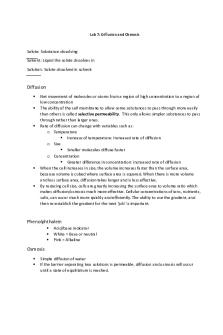Diffusion and Osmosis lab PDF

| Title | Diffusion and Osmosis lab |
|---|---|
| Author | Melissa Leon |
| Course | Biology I |
| Institution | City Colleges of Chicago |
| Pages | 4 |
| File Size | 181.8 KB |
| File Type | |
| Total Downloads | 6 |
| Total Views | 189 |
Summary
Lab report for Prof. Gopals class...
Description
DIFFUSION AND OSMOSIS Name: Melissa Leon Objectives: Describe the mechanism of diffusion at the molecular level. Define hypotonic, hypertonic, and isotonic in terms of relative concentrations of water and solute. Discuss the influence of the cell wall on osmotic behavior in cells Introduction: A cell membrane permits some materials to pass through while keeping other materials out. Such a membrane is called a selectively permeable membrane. Under normal conditions, water constantly passes in and out of this membrane. This diffusion of water through selectively permeable membrane is called osmosis Procedure: To begin the lab, click on link: https://video.esc4.net/video/assets/Science/Biology/Gateway%20Resources/cell %20homeostasis%20virtual%20lab%20-%20activity/index.html Lab report Instructions: 1. In your own words write a short paragraph below describing the experiments its results and how they relate to each other. 2. Take photocopies of each activity. 3. Go to the lab quiz and complete it. Attach to your report as a word document. Questions: 1. What question is this lab answering? What happens to a cell when it is in different environments? 2. How do you create 5% of a sugar solution? _50__g of sugar in _1000_mL of water 2. How do you create 10% of a sugar solution? _100__g of sugar in 1000_mL of water 4.How do you create 15% of a sugar solution? _150__g of sugar in 1000_mL of water
4. Record the initial mass of your tubes below Tube A Mass: ____17.59g____ Tube B Mass: ____8.75g____ Tube C Mass: ___11.24g____ Tube D Mass: _____10.71g__ Tube E Mass: __18.05g_____
5. Record the final mass of your tubes below Mass of Tube A (0%) in Beaker A (Control): __17.66g____ Mass of Tube B (10%) in Beaker B (0%): _10.40g_____ Mass of Tube C (10%) in Beaker C (5%): 12.10g_____ Mass of Tube D (10%) in Beaker D (10%): _10.57g____ Mass of Tube E (10%) in Beaker E (15%): _15.60g___ *Fill in the answers below based on what you answered on the virtual lab.
6. Which dialysis tube had little or no change in mass after 24-hr period?
A) A, C, E B) C, D C) A, D
7. Why was pure water used as a control group? A) The control group provides a standard for comparison for the experimental group. B) The control group represents a real cell because real cells contain water. C) The control group was not necessary.
8. Why didn’t the mass of dialysis tubes A and D change over the 24hr time frame? A) The dialysis tubing material was clogged B) The concentration both inside and outside the dialysis tube is the same. C) The pressure of the dialysis tubing membrane stabilizes the flow of water
9. Which statement below best describes how a cell responds to its external environment? A) The difference in concentration of solids in a cell’s external environment has no effect on how water moves into and out of a cell. B) If the concentration of solids in the cell’s external environment is greater than the internal environment. Water passes out of the cell C) If the concentration of solids in the cell’s external environment is less than the internal environment, the water passes out of the cell.
Lab Synopsis: This lab was giving a step-by-step process of a lab that we would do in person. It gave us an idea of an actual bio lab. I have done this lab in high school and it is interesting to see the liquid move across a barrier and not even notice it because of how minute it is. The purpose of this lab is to
show what happens when cells are in a hypotonic, hypertonic, or an isotonic environment. We were able to physically measure and chart the changes in the substances that acted as our cells....
Similar Free PDFs

Diffusion and Osmosis lab
- 3 Pages

Diffusion and osmosis lab
- 4 Pages

Diffusion and Osmosis lab
- 4 Pages

Lab 7: Diffusion and Osmosis
- 2 Pages

Lab 4 - Diffusion and Osmosis
- 6 Pages

Lab 4 Diffusion and Osmosis
- 7 Pages

Lab 5 Diffusion and Osmosis
- 1 Pages

Diffusion and osmosis lab 1
- 4 Pages

Diffusion and Osmosis Lab Report
- 8 Pages

Diffusion and Osmosis Lab Report
- 8 Pages

Diffusion & Osmosis Lab
- 10 Pages

Diffusion and Osmosis Worksheet
- 2 Pages

210 diffusion and osmosis
- 5 Pages

Osmosis and diffusion
- 2 Pages
Popular Institutions
- Tinajero National High School - Annex
- Politeknik Caltex Riau
- Yokohama City University
- SGT University
- University of Al-Qadisiyah
- Divine Word College of Vigan
- Techniek College Rotterdam
- Universidade de Santiago
- Universiti Teknologi MARA Cawangan Johor Kampus Pasir Gudang
- Poltekkes Kemenkes Yogyakarta
- Baguio City National High School
- Colegio san marcos
- preparatoria uno
- Centro de Bachillerato Tecnológico Industrial y de Servicios No. 107
- Dalian Maritime University
- Quang Trung Secondary School
- Colegio Tecnológico en Informática
- Corporación Regional de Educación Superior
- Grupo CEDVA
- Dar Al Uloom University
- Centro de Estudios Preuniversitarios de la Universidad Nacional de Ingeniería
- 上智大学
- Aakash International School, Nuna Majara
- San Felipe Neri Catholic School
- Kang Chiao International School - New Taipei City
- Misamis Occidental National High School
- Institución Educativa Escuela Normal Juan Ladrilleros
- Kolehiyo ng Pantukan
- Batanes State College
- Instituto Continental
- Sekolah Menengah Kejuruan Kesehatan Kaltara (Tarakan)
- Colegio de La Inmaculada Concepcion - Cebu

